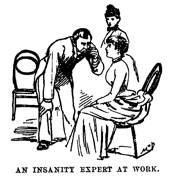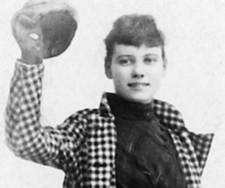|
|
|
 |
|
Nellie BlyA Pioneer of Investigative ReportingClick here to play the
audio version | |
|
Nellie Bly was the pen name of Elizabeth Jane Cochrane, one of
America's first woman journalists and a pioneer of investigative
reporting. |
 |
She quit school and moved to Pittsburgh when she was 16 to get away from her stepfather, and worked at a series of low-paying jobs. There were few employment options available to her and she resented the limitations that society placed on women. Elizabeth understood the danger of being dependent on a man, and that motivated her throughout her life to be self-sufficient and to work towards improving women's lives. In 1885, she read a column in the Pittsburgh Dispatch called,
What Girls are Good For, that argued that women should not vote or work,
but stay in the home and take care of children. She was so outraged that
she wrote an anonymous letter to the editor complaining about it. She
signed her letter "Lonely Orphan Girl." The editor was so
impressed with her letter that he placed an ad in the Sunday classifieds
asking her to contact him.
She wrote a book called, Ten Days in a Madhouse, and it made the 23 year old Nellie famous. Her courageous reporting prompted many much-needed reforms. The fact that she was very pretty young woman, working in a male-dominated industry and taking great risks, made her very popular with her readers. Nellie was the first woman to have her own byline on all her stories in a time when very few men were accorded that honor. Nellie became a champion of the poor and downtrodden. She focused on women's issues, social problems and corruption. She was fearless and passionate about her beliefs. Nellie was able to charm people and get them to trust her so that they would reveal to her the story behind the story. She went undercover as a chorus girl, a maid and an unwed mother. In an effort to get the story on poor treatment of women prisoners, she even got herself arrested for theft. Her editors dreamed up another publicity stunt to boost their circulation. They wanted to see if someone could travel around the world in less than the 80 days it took Phileas Fogg, the fictional character in Jules Verne's Around the World in 80 Days. Nellie wanted to do it, but the editors preferred to send a man because a man wouldn't require an escort. Nellie insisted that she could beat whoever they sent and she would be doing it for another newspaper if necessary. She got the assignment.
Nellie then married 70 year old millionaire Robert L. Seaman in 1895. It's likely that she married him more as an investment than for love, because he was 40 years older than her. He died soon after and she took over running his manufacturing businesses. Nellie instituted many reforms to help the workers, starting with eliminating piece work and added benefits like paid health care, gymnasiums and libraries. The business prospered, but by 1910, the accounting staff had embezzled much of the money and the company was forced into bankruptcy. Nellie went to Europe for a vacation to escape her troubles and was there at the start of World War I. She became the first female war correspondent, and her reporting from the front provided a vivid look at the war's cost in human terms. She spent four years reporting in Europe, and after her return home she went to work for the New York Evening Journal, writing an advice column. She did a lot of charitable work for the city's poor and focused on helping unwed mothers and abandoned children. Nellie Bly died of pneumonia in 1922, at the age of 55. Newspapers around the world carried her obituary and The New York World wrote, "Nellie Bly was THE BEST REPORTER IN AMERICA." |
|




